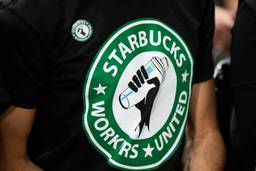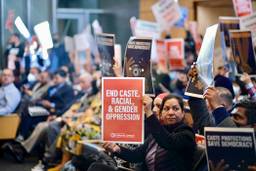What Unionized Starbucks Workers Think of Howard Schultz’ Testimony to Bernie Sanders
Former Starbucks CEO Howard Schultz was grilled over alleged union busting in front of a congressional committee this week. That’s not something you normally see in Washington.
Saurav Sarkar

The latest round in the fight between Starbucks and its nascent barista network — Starbucks Workers United (SBWU) — came to a head on Wednesday with the appearance of former CEO and current board member Howard Schultz at the Senate Committee on Housing, Education, Labor, and Pensions (HELP).
“It was honestly hard not to laugh out loud at some of the [bald-faced] lies he told,” said James Greene, a fired Starbucks shift supervisor in the Pittsburgh area.
“He denied breaking the law repeatedly as senators were listing off multiple judges’ rulings against [Starbucks],” Greene added.
Democratic senators alternately beseeched and challenged Schultz to live up to both his self-professed progressive values and the law, while Republicans by and large thanked him for his role as a billionaire businessman.
But if viewers were expecting an inquisition from the senators that would reveal new details about Starbucks’s anti-union push, instead they received what was mostly a milquetoast intervention met with successful stonewalling by Schultz.
For example, there was little discussion acknowledging that, along with the National Labor Relations Board (NLRB), federal courts have also found that workers’ claims of retaliation have merit. This allowed ranking Republican Sen. Bill Cassidy (R-La.) and other supporters of Schultz to muddy the waters with claims about NLRB bias.
Senators asked Schultz about why the company had not reached a contract with any unionized stores despite having had up to over 450 days to negotiate. They also inquired about the impact of cutting hours on benefits, short-staffing, administrative judges’ decisions against the company for retaliation against workers, and other issues that have come up over the course of the union campaign.
Schultz, however, insisted that both he and the company had followed the law in all respects. For example, in response to questions by Sen. Bernie Sanders (I-Vt.), the chair of the committee, Schultz denied knowledge of — or involvement in — decisions to fire or discipline workers who were involved in union drives. When and where he conceded on factual issues, such as an incident where he suggested that a pro-union worker should find another job, he construed such events in a way that cleared himself and the company of wrongdoing.
Greene noted that even as Schultz was speaking about worker safety at the committee, around 10:30 am Wednesday at a Starbucks store in the Pittsburgh area workers faced an unnerving situation. “The fire alarms went off and announced a shelter in place and lockdown,” an unnamed Starbucks worker reported over Twitter. There were reports of an active shooter in the area.
Though the reports turned out to be false, “we were in lockdown for around half an hour… People were crying in the back and were visibly upset,” the worker said. Minutes after the lockdown ended, the manager and district manager tried to require workers to start serving coffee again, according to the worker.
Starbucks did not reply to a request for comment from In These Times by the time this article was published.
Meanwhile, when asked repeatedly why the company refuses to bargain in earnest, Schultz cited the perceived need to avoid Zoom at bargaining sessions in order to protect employee safety for managers or district managers who might be doxxed or visited at their homes.
The two different perspectives on what constitutes a danger to Starbucks workers revealed a deeper contrast in the perspectives of upper management and those on the shop floor. While Schultz dodged questions about the legality of Starbucks’s union-busting tactics, baristas were dealing with sub-living wage incomes, cuts to their hours and retaliation against union activities.
“Ultimately, I have come to accept that a billionaire (or whatever alternative [term] Howard would prefer) will never be able to reflect on [the] shop floor worker’s level and therefore have learned to cope that we might never see an apology or admission of guilt from him,” said Mason Boykin, a Starbucks worker based in Jacksonville, Florida.
Nonetheless, some Starbucks Workers United (SBWU) baristas were left satisfied that Schultz was at least being forced to answer more difficult questions than usually confronted with in the press.
“I think that they obviously had some people that were more sympathetic to him,” says Hopewell, New Jersey, shift supervisor Sara Mughal. She added, “But there [were] a lot of people asking the questions that we’ve been waiting for people to ask him in all of these interviews that he’s given.”
After Schultz spoke, Starbucks worker Maggie Carter and fired Starbucks worker Jaysin Saxton had the opportunity to speak to the assembled senators.
“What’s important to me is that our government invited this conversation and even more importantly, gave space to hear directly from workers like Maggie and Jaysin,” said Boykin.
“It was so incredibly inspiring to see support from some of the most influential people in the country and know that those watching saw themselves reflected in my fellow partner’s testimony,” they added.
Since the barista campaign began roughly 19 months ago, Sanders has been a fierce ally of the Starbucks workers, who have organized nearly 300 store unions and over 7,000 workers in the coffee megachain’s U.S. company-run outlets. However, this represents just roughly 3% of such stores in the multi-billion dollar corporation.
The hearing came after months of mounting pressure by the baristas and their allies, including Sanders. In the first phase of the campaign in 2022, the victory at the first store in Buffalo over union-busting tactics that an administrative judge deemed “egregious and widespread” led to an exponential increase in stores filing for unions across the country.
In the second phase, Starbucks retaliated through implementing selective benefits and raises applied to non-union stores, closures of some union or unionizing stores, firings of union organizers, intensification of disciplinary measures against pro-union workers, and other tactics. Through this process, the company managed to staunch the number of stores filing for unions by the summer of 2022.
However, over the course of autumn and winter 2022, baristas counterattacked. In early August, they held in Massachusetts their first regionally coordinated strike. In November and December, workers struck nationally at about 100 stores. Most recently, they went on strike again about a week ago at 113 stores, according to SBWU.
They also won a major victory this week as Starbucks shareholders voted against the recommendation of its board of directors for a resolution urging the board to commission an external investigation into worker rights issues. The measure calls for a look at whether the company is adhering to core International Labour Organization Core Standards, which include freedom of association. The shareholder coalition that successfully brought forward the resolution was led by New York City Comptroller Brad Landers.
“It’s not just a one-store fight. It’s a nationwide fight,” said Ana Martinez, a Starbucks barista in Lynbrook, New York. “I’m just glad that this has brought us all together.”







